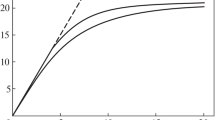Conclusions
Despite the complexity of the linearized equations for a CRM having a high-frequency field of nonfixed structure, many of the most important characteristics of the starting regime in systems with arbitrary Q can be obtained analytically by the prescribed-field method or the dispersion-equation method. Where necessary, more exact results may be obtained by numerical investigation (1)–(3). Analysis of the self-excitation conditions for elementary systems (Fig. 1) on the basis of these methods leads to the following results.
-
1)
The starting current (all other parameters being equal) is determined by the ratio of resonator Q to the minimum diffractional Q and depends weakly on the specific methods used to create wave reflection (contraction or expansion of the waveguide at the ends of the working space).
-
2)
When the adjustment of the magnetostatic field is varied, the structure of the high-frequency field is continuously deformed, since there is an increase in the number of longitudinal variations as the field strenght H0 rises. In a CRM with a high-Q (Q≪Q*) resonator, the greatest changes in field structure take place in tuning regions where self-excitation is impossible according to the prescribed-field approximation.
-
3)
The self-excitation of parasitic modes having the same transverse field structure as the working mode will be excluded if the electron-beam current is less than the starting current of the mode having q =1 for amplifiers of the CRM-klystron or CRM-twistron type and of the mode having q=2 for a CRM monotron. The starting-current ratio for modes with q=1 and q=2 in a CRM with a low-Q electrodynamic system is of the order of 4–7.
-
4)
The greatest danger in low-Q systems is the excitation of competing modes having lower critical frequencies than that of the working mode, since the value of starting current rises slowly on the high-frequency branches of the I(δ) curves and rapidly on the low-frequency branches (in the first case, there is continuous fine tuning to resonance with the opposed wave as the magnetic field increases, ω+hv∥-nωH≈0; in the second case, the condition for resonance interaction with either the opposed or cotraveling wave is rapidly violated).
Similar content being viewed by others
Literature Cited
A. V. Gaponov, M. I. Petelin, and V. K. Yulpatov, Izv. Vyssh. Uchebn. Zaved., Radiofiz.,10 No. 9-10, 1414 (1967).
V. L. Bratman, M. A. Moiseev, M. I. Petelin, and R. É. Érm, Izv. Vyssh. Uchebn. Zaved., Radiofiz.,16, No. 4, 622 (1973).
S. N. Vlasov, G. M. Zhislin, I. M. Orlova, M. I. Petelin, and G. G. Rogacheva, Izv. Vyssh. Uchebn. Zaved., Radiofiz.,12, No. 8, 1236 (1969).
M. I. Petelin and V. K. Yulpatov, Izv. Vyssh. Uchebn. Zaved., Radiofiz.,18, No. 2, 290 (1975).
V. L. Bratman, Izv. Vyssh. Uchebn. Zaved., Radiofiz.,17, No. 10, 1544 (1974).
K. K. Chow and R. H. Pantell, Proc. IRE Trans.,48, No. 11, 1865 (1960); Zarubezh. Radioélektron.,4, 82 (1961).
K. K. Chow and R. H. Pantell, IRE Trans.,ED-9 No. 4, 351 (1962).
V. K. Yulpatov, Vopr. Radioélektron., Ser. 1, Élektronika, No. 12, 15 (1965). V. N. Gol'dberg, N. A. Ezhevskaya, G. M. Zhislin, M. N. Orzhekhovskaya, and V. K. Yulpatov, Vopr. Radioélektron., Ser. 1, Élektronika, No. 12, 24 (1965).
I. S. Kovalev, A. A. Kuraev, E. M. Demidovich, and F. G. Shevchenko, Dokl. Akad. Nauk BelorusSSR,15, No. 8, 692 (1971);16, No. 1, 24 (1972).
S. I. Vyrovoi and G. N. Rapoport, Izv. Vyssh. Uchebn. Zaved., Radioélektron.,16, No. 10, 96 (1973).
V. L. Bratman, S. L. Novozhilov, and M. I. Petelin, in: Reports to the Conference on Microwave Electronic Devices and Their Fields of Application [in Russian], Tomsk (1972).
M. A. Moiseev and M. I. Petelin, in: Reports to the Conference on Microwave Electronic Devices and Their Fields of Application [in Russian], Tomsk (1972).
M. A. Moiseev and R. É. Érm, in: Report to the Conference on Microwave Electronic Devices and Their Fields of Application [in Russian], Tomsk (1972).
J. R. Pierce, Traveling-Wave Tubes [Russian translation], Izd. Sov. Radio, Moscow (1952).
Additional information
Scientific-Research Institute of Radiophysics. Translated from Izvestiya Vysshikh Uchebnykh, Zavedenii, Radiofizika, Vol. 18, No. 7, pp. 1045–1055, July, 1975.
Rights and permissions
About this article
Cite this article
Bratman, V.L., Moiseev, M.A. Conditions for self-excitation of a cyclotron resonance maser with a nonresonant electrodynamic system. Radiophys Quantum Electron 18, 772–779 (1975). https://doi.org/10.1007/BF01036776
Received:
Issue Date:
DOI: https://doi.org/10.1007/BF01036776



